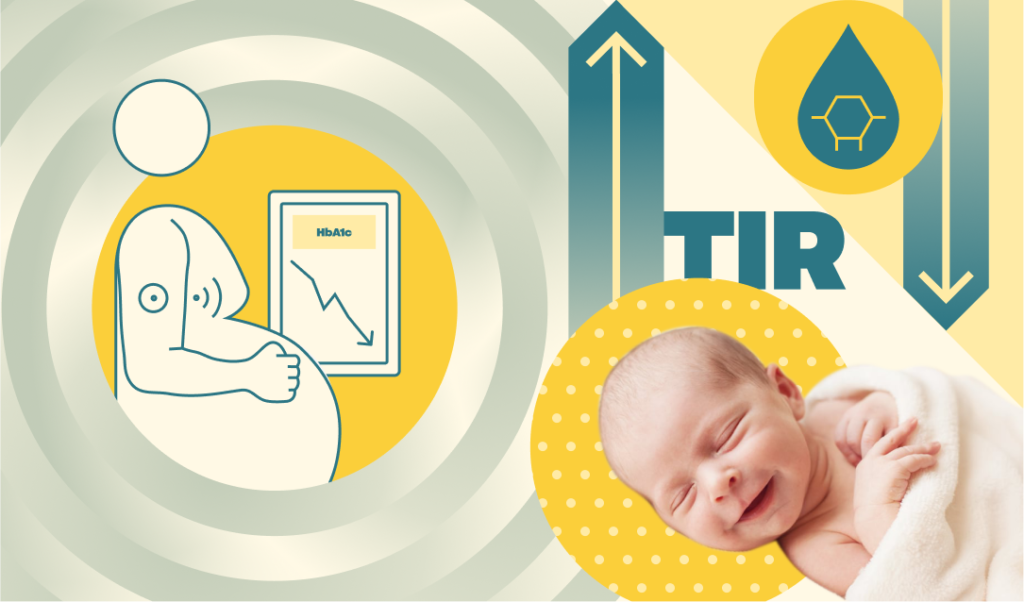Continuous Glucose Monitoring in
pregnant women with type 1 diabetes CONCEPTT:
a multicenter
international randomized
controlled trial.
Published Date:
Sep 25, 2017
Written By:
Denice S Feig, Lois E Donovan, Rosa Corcoy et.al. CONCEPTT Collaborative Group
Approved By:
Professor Eleanor Scott BM BS MD FRCP
Professor Helen R. Murphy MBBChBAO, MD, FRACP
Asra H. Ahmed MBA, PGCE in Assessment Learning disability, Diabesties Foundation.
5 mins to read
- The T1D Takeaway
- CGM was seen to ease the burden of a woman planning to have a baby thus the device should be incorporated in clinical antenatal care.
- The data showed remarkable improvement in babies born without being larger for gestational age and not needing NICU admission.
- A simple device that improves mother’s glycemic control leading to healthy pregnancy and happy outcomes is extremely relevant to any woman living with type one diabetes.
Word Wizard
- Compare the use of finger sticks and CGM to improve outcomes for women planning to get pregnant or already pregnant and living with type 1 diabetes.
- Assess infant’s growth at 24 & 34 weeks and need to be admitted into NICU.
- Use of CGM in place of finger sticks allowed intensive blood sugar monitoring. The women were able to customize their insulin dosage to improve glucose control and improved baby’s growth. Reducing the number of babies that needed intensive care.
- Women who took part came from several western countries.

Summary Snap Shots
It is concluded offering all pregnant women or planning a pregnancy should be routinely offered a CGM rather than finger sticks. This showed significant reduction in HbA1c levels, accompanied by an increased time in target and less glycemic variability during pregnancy and better outcomes for babies.
Prime Insight

It has been noted in previous research that when optimal blood glucose levels are maintained when planning and during pregnancy, outcomes are improved.

Fewer babies needed NICU admissions longer than 24 hours, and glucose to treatments after birth.
Use of CGM significantly reduced complications in pregnancy and to the baby.
Mothers using CGM were more satisfied and content after their delivery. Further data of over 68% time in range can be provided but cost of including CGM in antenatal care is yet to be investigated. The seven-hour higher time in range is a major success, but it also highlights the need for real world studies if CGM can be provided to women free of cost in all antenatal clinics. It was observed women in this study were also overweight or gained more weight as they chose tighter control. This aspect needs further research to see if there are more live births for those using CGM.

Consequently, as fewer NICU beds were occupied, thus the use of CGM has shown to reduce the financial burden post-delivery.

CGM should be offered as a standard tool in antenatal care for women living with type 1 diabetes.
- A Deeper Dive
- CGM was seen to ease the burden of a woman planning to have a baby thus the device should be incorporated in clinical antenatal care.
- The data showed remarkable improvement in babies born without being larger for gestational age and not needing NICU admission.
- A simple device that improves mother’s glycemic control leading to healthy pregnancy and happy outcomes is extremely relevant to any woman living with type one diabetes.
- The Source Voice
Guideline recommendations in type 1 diabetes in pregnancy should be revised to recommend offering CGM to pregnant women with type 1 diabetes using intensive insulin therapy in pregnancy.
- Curiosities Clarified
It was found that use of CGM during pregnancy in people with type 1 diabetes is associated with improved neonatal outcomes, which are likely to be attributed to reduced exposure to maternal hyperglycemia.
The primary outcome was difference in change in HbA1c from randomization to 34 weeks’ gestation in the pregnancy trial and to 24 weeks or conception in the planning pregnancy trial, further study is suggested in use of CGM during 1st trimester.
Continuous glucose monitoring on health outcomes other than glycemic outcomes, and with substantial reductions in neonatal complications attributed to maternal hyperglycemia. The results were consistent across 31 international study sites and comparable for women using insulin pumps or multiple daily injections. Thus, it can be suggested use of CGM would be beneficial across the populations.
Women using both pump therapy and multiple daily injection showed significant improvement in TIR, HbA1C, fewer NICU admissions and large for gestational age infants.
Validity and strength of this study lies in the sample size across various population using more and less technology.

2 Comments
Its very useful article.
Good One!